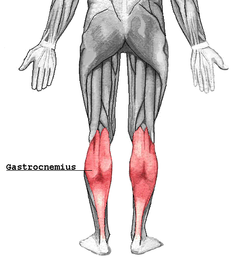Gastrocnemius: Difference between revisions
No edit summary |
No edit summary |
||
| Line 40: | Line 40: | ||
== Clinical significance & Function == | == Clinical significance & Function == | ||
As gastrocnemius is strong plantarflexion but | As gastrocnemius is strong plantarflexion but enters a stage of ''passive insufficiency'' during full dorsiflexion of ankle joint when the knee is near it or in full extension. As the knee flexion increases (soleus become more active). In the seated calf raise (knees flexed to 90º), the gastrocs are virtually inactive while the load is borne almost entirely by the soleus. <br> | ||
The lateral and medial head of gastrocnemius muscle do not involve in the hip rotation but in and MRI study by Dr. Per Tesch (Sweden) suggests "toes in" activate both heads and "toes out" activate the medial head to a higher degree.<br> | The lateral and medial head of gastrocnemius muscle do not involve in the hip rotation but in and MRI study by Dr. Per Tesch (Sweden) suggests "toes in" activate both heads and "toes out" activate the medial head to a higher degree.<br> | ||
== Palpation == | == Palpation == | ||
Revision as of 15:50, 8 May 2014
Original Editor :Aarti Sareen
Top Contributors - George Prudden, Aarti Sareen, Rishika Babburu, Admin, Andeela Hafeez, Kim Jackson, Evan Thomas, Venus Pagare, WikiSysop, Joao Costa, Lucinda hampton, Daphne Jackson and Samuel Adedigba
Introduction[edit | edit source]
Gastrocnemius forms the major bulk at the back of lower leg and is a very powerful muscle. It is a two joint or biarticular muscle and has two heads and runs from back of knee to the heel. It has a function in any ambulatory movement for example walking, running and jumping. Together with Soleus and Plantaris together forms the calf muscle or triceps surae. Occasionally there are sesamoid bones called "fabella" in the lateral head of gastrocnemius muscle.
Anatomy[edit | edit source]
ORIGIN
The two heads unite into a broad aponeurosis which eventually joins with the deep tendon of the soleus to form the Achilles tendon at it insertion.
Medial head: from posterior nonarticular surface of medial femoral condyle
Lateral head: from lateral surface of femoral lateral condyle.
INSERTION
The middle 1/3 of the posterior calcaneal surface.
ACTION
Powerful plantarflexion at ankle joint.
Flexion at knee joint.
INNERVATION
Tibial nerve (S1,S2)
ARTERIAL SUPPLY
Each head supplied by a sural branch of the popliteal artery.
Clinical significance & Function[edit | edit source]
As gastrocnemius is strong plantarflexion but enters a stage of passive insufficiency during full dorsiflexion of ankle joint when the knee is near it or in full extension. As the knee flexion increases (soleus become more active). In the seated calf raise (knees flexed to 90º), the gastrocs are virtually inactive while the load is borne almost entirely by the soleus.
The lateral and medial head of gastrocnemius muscle do not involve in the hip rotation but in and MRI study by Dr. Per Tesch (Sweden) suggests "toes in" activate both heads and "toes out" activate the medial head to a higher degree.
Palpation[edit | edit source]
Pathology[edit | edit source]
Resources[edit | edit source]
http://orthoinfo.aaos.org/menus/foot.cfm
http://footandankleinstitute.be/
http://www.aofas.org/Pages/Home.aspx







